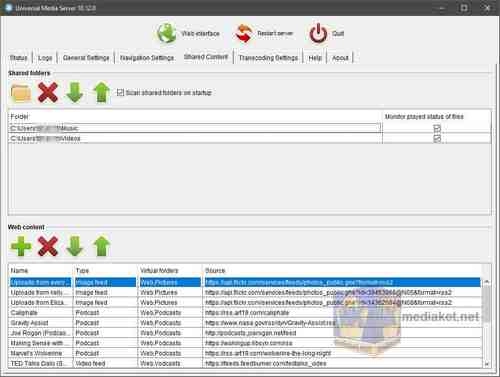Universal Media Server (UMS) is an open-source media server software designed to facilitate the streaming and sharing of multimedia content across various devices on a home network. It is a versatile and feature-rich media server that has gained popularity for its ability to handle a wide range of media formats and offer a seamless media streaming experience...
Features of Universal Media Server (UMS):
Cross-Platform Compatibility:
UMS is compatible with multiple operating systems, including Windows, macOS, and Linux, making it accessible to a wide range of users.
Media Format Support:
UMS supports a vast array of media formats, including video, audio, and image formats. This ensures that you can stream virtually any type of multimedia content to your devices.
Automatic Media Detection:
UMS can automatically detect and catalog media files in your specified directories, making it easy to organize and stream your media library without manual intervention.
Transcoding:
One of UMS's standout features is its powerful transcoding capabilities. It can transcode media on-the-fly to ensure compatibility with the target device. This means that even if your device doesn't natively support a specific format, UMS can convert it in real-time for smooth playback.
Subtitle Support:
UMS can display subtitles for your media files, allowing you to enjoy content in multiple languages or for hearing-impaired viewers.
Customization:
UMS provides various settings and configuration options to customize the streaming experience. Users can fine-tune transcoding settings, choose subtitles, and control the quality of streaming.
Remote Access:
UMS allows remote access to your media server, enabling you to stream your content over the internet securely. This is useful for accessing your media library while away from home.
Device Compatibility:
UMS is compatible with a wide range of devices, including smart TVs, gaming consoles, smartphones, tablets, and more. It supports DLNA, UPnP, and other protocols for seamless connectivity.
Web Interface:
UMS has a web-based interface that allows you to manage your media server, monitor its performance, and access your media library remotely.
Pros of Using Universal Media Server:
Open Source:
UMS is open-source software, which means it's free to use and has an active community of developers and users. This ensures ongoing development and support.
Wide Format Support:
UMS's extensive media format support means you're not limited by the types of media files you can stream, making it versatile for all your media needs.
Automatic Organization:
The automatic media detection and cataloging features save you time and effort in managing your media library.
Transcoding:
The ability to transcode media on-the-fly is a significant advantage, as it ensures compatibility with a wide range of devices, even those with limited format support.
Remote Access:
UMS's remote access feature lets you enjoy your media library from anywhere with an internet connection, increasing convenience and accessibility.
Customization:
Users can tailor their streaming experience by adjusting settings to match their preferences, ensuring an optimal viewing experience.
Active Community:
With an active user community, you can find support, plugins, and updates readily available, enhancing the software's longevity and functionality.
Multi-Platform Compatibility:
UMS works seamlessly on various operating systems, so you can use it on your preferred platform without limitations.
Reliability:
UMS is known for its stability and reliability, providing a consistent streaming experience.
In summary, Universal Media Server is a versatile and powerful media server software with a wide range of features that cater to users who want to stream and share their media content across devices. Its open-source nature, extensive format support, transcoding capabilities, and user customization options make it a popular choice for media enthusiasts looking to create their own home media server. Its ability to facilitate remote access and its compatibility with various devices further add to its appeal.
Universal Media Server - Changelog.
Here's how to use Universal Media Server :
1. Download and Install:
- Download the version compatible with your operating system.
- Run the downloaded installer and follow the on-screen instructions to complete the installation.
2. Add Your Media Files:
- Open Universal Media Server.
- In the main window, click on the "Shared Folders" tab.
- Click the "Add" button and browse to the folders containing your media files (videos, music, pictures).
- You can add multiple folders by repeating this step.
3. Configure Sharing Options (Optional):
In the "Shared Folders" tab, you can right-click on a shared folder and select "Properties".
This allows you to configure options like:
- Restricting access to specific devices by Device Name or MAC address.
- Choosing which media types (videos, music, images) to share from that folder.
4. Start the Media Server:
- In the main window, click the "Start" button.
- Universal Media Server will scan your shared folders and build its media library.
5. Accessing Your Media with DLNA Devices:
- Now, on your DLNA-compliant devices (Smart TVs, media streamers, gaming consoles, etc.), look for the option to access media servers.
- The device should discover your Universal Media Server on the network.
- Browse the server and select the media files you want to stream.
Additional Tips:
- Universal Media Server can transcode media files on the fly if your device doesn't support the original format. However, this might use more system resources.
- You can access the "Settings" menu to configure various aspects of the server, such as network ports, transcoding options, and web interface settings.
- For detailed information and troubleshooting steps, refer to the Universal Media Server User Manual.
Download Universal Media Server:
Size: 191.00 MB

